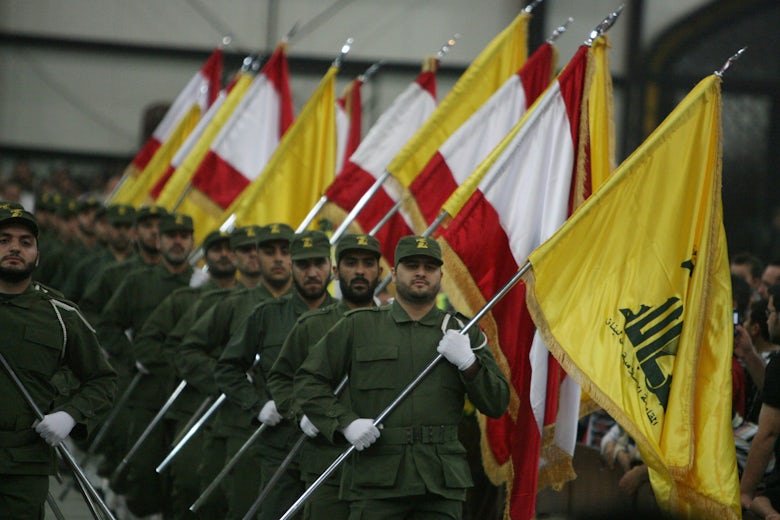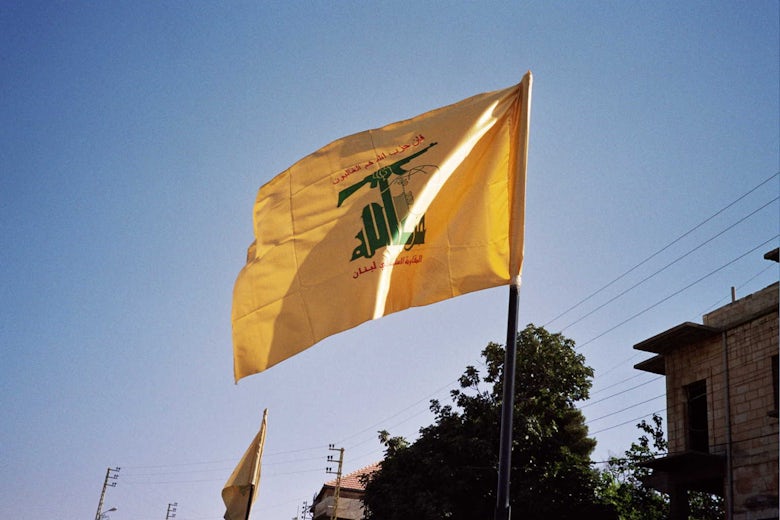Hezbollah, meaning the "Party of God" in Arabic, is a Shia Islamist terrorist group and a political party in the Lebanese Parliament. Supported and heavily financed by Iran, it serves as the country’s strongest proxy in the Middle East.
The United States of America, the United Kingdom, Germany, the Gulf Cooperation Council (comprising seven Arab states of the Persian Gulf, excluding Iraq), and Israel are among a growing number of countries that recognize Hezbollah, in its entirety, as a terrorist organization. The European Union has designated Hezbollah's military wing as a terrorist organization, differentiating between the military wing and the organization’s ‘political’ wing.
After the 1979 Islamic Revolution, Iran started to play a critical role in the formation of Hezbollah, providing the terrorist organization with financial and military support in exchange for the consolidation of the new regime’s power.
Established in 1982 during the Lebanese Civil War, Hezbollah's founding was largely in response to the Israeli invasion of Lebanon, which attempted to counter the Palestine Liberation Organization’s (PLO) operations. The invasion exacerbated already severe social and political tensions within Lebanon, which had been mired in a civil war since 1975. The war split Lebanon’s Christian and Muslim populations, with the Christians siding with the West, while the Muslims and other sociopolitical groups sided with the East. Southern Lebanon’s widespread displacement contributed to a favorable environment for Hezbollah’s mobilization.
After the 1979 Islamic Revolution, Iran started to play a critical role in the formation of Hezbollah, providing the terrorist organization with financial and military support in exchange for the consolidation of the new Shah’s power.
The new Islamist regime viewed the Lebanese Shia community as a potential ally in exporting its revolution and countering Sunni-dominant political dynamics in the Middle East. Iran's Revolutionary Guard Corps (IRGC) was instrumental in building up Hezbollah as its personal platoon after the 1982 Israeli invasion, despite some of the Lebanese political parties’ strong opposition to the Corps’ presence. Despite this outrage, the IRGC is credited with developing Hezbollah through tactical training and organization. Hezbollah pledges allegiance to Iran’s supreme leader and has advocated for an Islamist regime, while emphasizing that the Lebanese people must have the freedom for self-determination.
Over time, Hezbollah expanded its objectives beyond just military resistance: In an effort to garner support amongst the Lebanese Shia community, the organization started to provide social services to places such as hospitals and schools. Additionally, Hezbollah began to participate in Lebanese politics, further solidifying its presence and influence in the country.
Hezbollah’s current leader, Hassan Nasrallah, arose to power in 1992 following Israel’s targeted operation that eliminated the group’s cofounder Abbas Musawi.
The 1979 Iranian Revolution triggered the downfall of Iran’s traditional monarchy, under the Shah Mohammad Reza Pahlavi, and instituted the new Islamic doctrine, under Ayatollah Ruhollah Khomeini. This, combined with the shared objective of annihilating Israel and expelling Western powers from Lebanon, formed the ideological bedrock of Hezbollah.
This Shia Islamist tenet, combined with the shared objective of annihilating Israel and expelling Western powers from Lebanon, formed the ideological bedrock of Hezbollah.
In 1985, the organization released its programmatic document in the form of a letter addressed to the “Downtrodden in Lebanon and the World.” According to this document, the Iranian Islamic regime’s main enemy was, and still is, the United States, which was charged with using Israel as its “spearhead” to inflict suffering on the Muslims of Lebanon. The organization positioned itself as a force that resists the actions of Israel and the superpowers (at the time, other than the United States, they were mainly France and the Soviet Union), which led to oppression throughout the Third World.
Hezbollah justified its use of violence by claiming that “each of us is a combat soldier when the call of jihad demands it”. The organization makes it clear that it opposes any negotiation with Israel and its ultimate objective is to destroy Israel and liberate “Palestine.”

Even before Hezbollah was formally constituted, several of its founding members, working hand in hand with Iran, were involved in the 1983 truck bombings against the U.S. embassy in Beirut. The bombings resulted in the deaths of 63 people, and later that year, the bombing of U.S. and French military barracks, also in Beirut, resulted in 241 American and 58 French fatalities. These attacks signified Hezbollah’s willingness to target foreign entities involved in the Lebanese Civil War.
In the late 1980s and early 1990s, the group gained worldwide notoriety after it conducted a series of kidnappings of Western citizens in Lebanon. Some hostages were held for years, including CIA station chief William Buckley and marine officer Richard Higgins, and others died in captivity under severe conditions and brutal torture.
Despite its enormous presence in the Middle East, Hezbollah's reach navigated its way across transnational borders in 1992, following the assassination of Musawi, when the Israeli embassy in Buenos Aires, Argentina, was bombed, killing 29 people. Two years later, in 1994, a Jewish community center in the same city was attacked, resulting in 85 deaths, most of them Jews. Many knowledgeable observers believe that both attacks, the first only months after Musawi’s death, were the joint work of Hezbollah’s external security organization and Iran.
In July 2006, six years after Israel withdrew all its forces from Lebanon, Hezbollah launched a cross-border raid into Israel, killing three Israeli soldiers and capturing two others. In response, Israel launched a massive air and ground offensive against Hezbollah in Lebanon, also known as the Second Lebanese War. The war lasted for 34 days and resulted in the deaths of over 1,200 Lebanese people, among them hundreds of civilians and 160 Israelis, 44 of whom were civilians.
Hezbollah's last major, internationally recognized act of terror was the 2012 bombing of a bus carrying Israeli tourists in Bulgaria, which killed six people and wounded over 30. Subsequent attempts to target Israelis, from Cyprus to Azerbaijan, have been foiled by local intelligence agencies working hand in hand with Israel.
Hezbollah's engagement in Syria's civil war began in 2012 and marked a significant shift in its operations, extending its influence and activities outside Lebanon. Its longtime allyship with the Assad regime solidified the jihadist organization’s military support, despite public statements refuting its position in the conflict. 2012 marked the end of these allegations, as Hezbollah’s invasion of eight Syrian villages marked its official debut to the war.
Joining Iran and Russia in the fight, alongside forces loyal to President Bashar Assad that were primarily against Suni rebel groups, it is estimated that Hezbollah sent more than 7,000 militants to fight in Syria. Iran and Hezbollah provided an impenetrable supporting wall to the Assad regime, attributing its success to the jihadist forces; the caveat being that the public display came with Israel, a fierce opponent of Hezbollah’s allyship with both Syria and Iran, hot on its heels. The efforts to diffuse Hezbollah’s role in the fight led to continuous Israeli strikes against targets in Syria, to prevent weapon supplies from reaching Hezbollah and also to prevent the establishment of an Iranian-allied, controlled zone in southern Syria.
Since 2014, Hezbollah has been actively involved in supporting the Houthi insurgents, who belong to the Shiite Muslim faction, in the Yemeni Civil War. Initially, Hezbollah focused on transferring funds and providing training to the insurgents as their main activities in the conflict. As the war progressed, Hezbollah began sending militants to the region to support the Houthi, despite the stirring controversy from Saudi Arabia. As a result, two years later Saudi Arabia pulled its proposed $3 billion military aid to Yemen, blaming Hezbollah’s interference.
While Hezbollah still receives most of its funding from Iran, as the latter has been strained by sanctions and its role in the losses of regional proxy wars, the organization has increasingly turned to criminal proceeds. Its “global criminal support network”, as it is defined by the United States Drug Enforcement Administration (DEA), taps into the Lebanese diaspora, which consists of Hezbollah members, drug and arms traffickers, illicit financiers, sanctions violators, and other types of organized crime individuals.

Despite Israel’s efforts, Hezbollah has amassed tens of thousands of advanced missiles in Lebanon as part of its ‘precision project’ in preparation for a future conflict with Israel. With its host state, Lebanon, on the brink of political collapse, the organization will have to consider the extent of civilian casualties and destruction that the “Third Lebanon War” with Israel will inevitably lead to.
In Lebanon, distrust in Hezbollah has grown because of its alleged involvement in the 2020 Beirut port explosions, which killed over 200 people. This was reflected in the number of anti-establishment candidates that were elected to Parliament in 2022. Hezbollah has also lost popular esteem in the Arab world; it is commonly derided, most notably in the Saudi-funded media, for its connection to the theocracy in Iran and its implication in the assassination of the former prime minister, Rafik al-Hariri, in 2005 and other terrorist attacks.
Israel responded with resolve by introducing a cutting-edge laser-based defense system designed to counter missiles and drones. This system, developed to enhance the existing Iron Dome and David’s Sling, is anticipated to significantly bolster the deterrence capabilities of the Israel Defense Forces (IDF).
